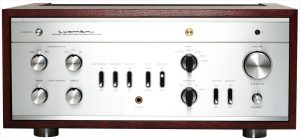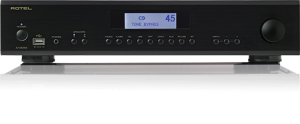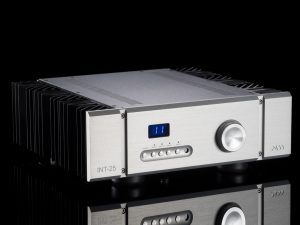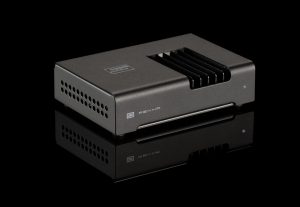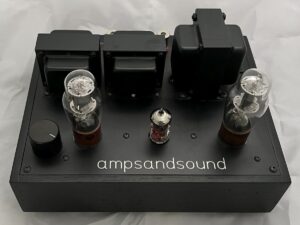The SPEC company and its founder, Mr. Shirokazu Yazaki, as well as its main constructor, Mr. Banno Tsutomu, have a special place in my heart. I was the first person from outside Japan to test the company's products and my relationship with Mr. Shirokazu is especially close. It was no coincidence that he described the history of his career for High Fidelity, later copied many times by other magazines an portals all over the world (see: Moja prywatna historia audio (My private audio history). So, in a way I feel responsible for SPEC.
Mr. Shirokazu Yazaki is an extremely experienced person who has worked as the head of the design departments of Teac and Pioneer, among others. He and Mr. Banno Tsutomu value and have profound knowledge of tube amplifiers, including those based on really rare tubes. Apart from that, they value vintage-type cables, e.g. the American Insulated Wire Corporation WE16ga and the Belden 8402, which they use in their private systems (more HERE and HERE). I have been using passive speaker filters developed by SPEC, counteracting the electromotive force that is generated in a woofer for many years—first it was the RSP-101 model, then the RSP-501EX and now it is the RSP-901EX.
Although both experts like vintage solutions and NOS, they took a different approach to their products. Their amplifiers, which constitute the heart of the company offer, are based on analog D-class power amplifiers. When we compare mass products to specialized SPEC devices, we can see that technology is one thing and its application is another; the comparison resembles a competition between, let us say, Audi A8 and Bugatti Veyron—the engines are built according to the same principle, they are even similar and use the same fuel, but…
RSA-F33EX
The tested amplifier is the manufacturer's top-of-the-range model. It is made as it could be expected from a product manufactured by a small Japanese firm that has the right technology. It has a double housing made of a steel chassis that also constitutes a screen for the impulse circuit inside and from thick aluminum panels. The bottom has been reinforced and decoupled using a wooden oak plate with three wooden feet (two at the front, one at the back). The wood is prepared by the Oak Villagecompany a Japanese manufacturer of furniture, wooden toys and, for example, barrels for the wine industry.
The heart of the device is the PWM International Rectifier IRAUDAMP4 DB modulator. Analog input signal is fed into it and modulated impulses come out of it. It was developed together by Mr. Yazaki and his friend, an engineer working for International Rectifier, Mr. Honda (a younger colleague from Pioneer). It controls FET transistors operating in a bridge. An analog low-pass filter has to be installed on the output of D-class amplifiers, consisting of two elements: a coil and a capacitor—it is an especially sensitive element of the structure. The SPEC company uses sophisticated oil capacitors manufactured by Arizona Capacitors there. These are exact replicas of the WEST-CAP CPV09 0.47 μF/600 V "Hermetic-seal" capacitors, originally manufactured for the American army in 1967.
Finally, the amplifier itself: classic D-class amps are powered by impulse circuits that are easy to connect to the amp's circuit in order to optimize their performance. Still, however, an old and reliable line amplifier with a large transformer has its advantages that are hard to copy in an impulse circuit. And here we have such an amp, with an enormous R-core transformer. In its basic configuration, the RSA-F33EX does not have a remote control, any tone color adjustment, digital inputs, a phono input, or a headphone output. It is a classic product with a "twist" inside. It costs a lot, but I know from my experience that SPEC is one of few manufacturers that propose sound which is very close to the sound of tube amplifiers, but without tubes and with a much higher power at a fraction of the price.
A remote control can be bought separately. Its receiver is connected to the amplifier using a cable with a mini-jack, in this way locating problematic circuits outside. The Polish distributor adds the remote control for free. Outside Poland, you will need to pay for it.
TEST METHODOLOGY
The amplifier was compared to two points of reference—the Kondo Overture II integrated tube amplifier (134,000 PLN), operating in the push-pull mode with the EL34 power pentodes and a two-piece system consisting of the Ayon Audio Spheris III line preamplifier (112,000 PLN) and the Soulution 710 power amp (not manufactured, 130,000 PLN).
Two sets of cables were used in the system—the Siltech Triple Crown and the vintage American Insulated Wire Corporation WE16ga and Belden 8402 cables. The SPEC amp was powered using the Harmonix X-DC350M2R Improved-Version cable.
The loudspeakers used were the Harbeth M40.1, placed on Acoustic Revive Custom stands. The SPEC Real-Sound Processor RSP-901EX filters were connected to the speaker inputs of the loudspeakers using the American Insulated Wire Corporation WE16ga cables.
THE LISTENING SESSION
- Il Canto D'Orfeo, performed by Il Trionfo del Tempo, Et'Cetera | Klara KTC 4030, CD (2009)
- Artur Rojek, Składam się z ciągłych powtórzeń, Kayax Music 071, CD (2014); review HERE
- Chet Baker, It could happen to you, Riverside/ZYX Music OJC20 303-2, "Original Jazz Classics", Super Bit Mapping CD (1958/1987)
- Diorama, The Art of Creating Confusing Spirits, Accession Records EFA 23450-2, CD (2002)
- Dizzy Gillespie, The New Content, Limelight/Universal Music Japan UCCM-9097, "Immortal Jazz on Mercury. No. 47", CD (1962/2003)
- Frank Sinatra, Where Are You?, Capitol/Mobile Fidelity UDSACD 2109, "No. 251", SACD/CD (1957/2012)
- Johann Sebastian Bach, Sonatas & Partitas, performed by Jaap Schroeder, Smithsonian Collection of Recordings ADDA 581134/35, 2 x CD (1989)
- Novika, Tricks of Life, Kayax 013 CD (2006)
- OMD, English Electric, 100% Records/Sony Music Japan SICP-3810, CD (2013); review HERE
- Polish Jazz Quartet, Polish Jazz Quartet, Polskie Nagrania "Muza"/Warner Music Poland, "Polish Jazz | vol. 3", Master CD-R (1965/2016); review of the CD version HERE
It is an amplifier with a personality. It is no use pretending that all devices pursue credibility in the same way and that a given technology does not influence the shape of the musical message. Also the technologies used in the SPEC amplifier leave their fingerprints on sound, but the modifications that I am talking about are used in an especially sophisticated way and connected with one another differently than in other products of this type. As a result, we get a special and unique amplifier which combines the features known from other designs, but ones that are more expensive and different. The RSA-F33EX provides a surprising constellation of their strengths and weaknesses—a collection that decorates the sky of the audio world.
As I was testing the Kondo Overture II tube amplifier parallel to the SPEC model, it was extremely easy for me to issue a preliminary diagnosis and to formulate the first conclusions on its basis. It is because what we get from both of them, when it comes to the way of building a musical message and the accompanying emotions, is incredibly similar. The SPEC amp provides unambiguously warm, brilliantly filled sound which has no sharp edges or annoying sharpening. The sound is smooth and creamy.
However, the warmth that I am talking about does not affect the building of 3D images of instruments, i.e. does not enlarge those whose energy falls within the midrange. So, it is different than in the case of tube amplifiers of this type that automatically promote vocals, a warm trumpet with a damper, electric guitars having a warm tone color, etc. With this in mind, let us listen to baroque music, for example—I chose Il Canto D'Orfeo performed by Il Trionfo del Tempo—and we will see that something reverse is happening, i.e. vocals located on the listening axis are a bit further away and create a semicircle with other instruments. It was similar in the case of an extremely warm transcription of Chet Baker's album It could happen to you, on which the vocal is specially warmed up and smooth.
The Japanese amplifier demonstrates its warmth on a deeper level and more sensibly, i.e. its sound is "omnipresent"—it is a complete reproduction that orders space in front of us in its own way, with no space for sounds from our own room or acoustics, etc.—there is only the recording. What is interesting, it is true both for sophisticated chamber music—I still have concerts from this year's Misteria Paschalia festival in my mind—or a jazz vocal, but also for electronic, electro-rock and dark wave music.
Definitely "warm" and definitely "neutral" amplifiers have problems with recordings of this type. The SPEC amp surprised me in this respect, even after I had listened to it with other albums and it seemed to me that I already know something about it. OMD from the album English Electric, Novika from Tricks of Life, Diorama from The Art of Creating Confusing Spirits, an album after an album, I listened to this amp with an increasing respect for its constructors, being fully aware of what their point of reference was.
In this way, we return to the Kondo Overture II amp. This wonderful representative of the tube world is a close spiritual cousin of the RSA-F33EX. I have no doubt that both brands were established by people with high musical sensitivity—I am thinking of Mr. Hiroyasu Kondo and Mr. Shirokazu Yazaki—and both amps were designed by engineers (Mr. Ashizawa Masaki and Mr. Banno Tsutomu) who deserve the highest respect, as they managed to translate the abovementioned sensitivity, filtered through their experience and choices, into a specific product.
I am fully consciously recalling categories connected with beauty, even though it is hard to represent them in the form of numbers, tables and charts. Beauty is connected with engineering filtered through art. These are big words, so I would not like them to be taken lightly, but if it needs to be said, I am saying it: it is an amplifier which has its limitations, produces specific sound and is closer to a created world than to so-called objectivity, but at the same time it is unique and shows the more beautiful face of the world.
On the one hand, it is about warmth and density that I have talked about. On the other hand, it is about fantastic dynamics. It was a little weakness of the Kondo amplifier with its power limitations and high output impedance, i.e. a device struggling with the laws of physics. The SPEC amp has high power, so it plays any music in an almost full range. The treble and really low bass are not characterized by such high resolution and as differentiated as in the HF reference system. With good recordings, the amount of highs is absolutely sufficient, but they are quite warm. It is clearly heard that the attack is rounded and polished.
It is similar with bass. It is low, deep and beautifully integrated with the midrange. And now: this is a high-power amplifier. It is extremely universal, both when it comes to the possibility of driving loudspeakers, and the type of music and recordings played. So, one need not take the effectiveness of loudspeakers into account, but must consider their impedance. The rule is simple: the higher and more balanced the loudspeakers' impedance is, the better. However, both parameters must be taken into consideration together and if we listen to music close to loudspeakers or/and in a small room, 4-Ohm loudspeakers should not be a problem at all.
Anyway, building 3D images with their acoustics and the space that they require is limited here. Vocals that I mentioned before are not located at the front, but merge into the accompanying instruments. It is one of the features characteristic for D-class amplifiers. Similarly to differentiating the highs and lows, selectivity is also of secondary importance. We will not hear a falling pin, but rather feel a change in acoustics that will indirectly indicate it.
So, the enormous, carefully planned and dense sound stage is a great surprise. I admit that I have heard space being shaped around me in a similar fashion in my system only twice before – I am thinking of the Kondo OnGaku and the Einstein The Silver Bullet OT—the SPEC amp did it in the most spectacular way. It is about the fact that it extracts even small pieces of information about space from signal and assembles them to create more than just changes—an incredibly real, tangible sound "dome" put onto the place where we are sitting.
One will need to get used to the fact that the depth of the spatial image on the listening axis, i.e. the depth of the stage will be limited. The amp does not bring forward the foreground to us, but rather moves the whole image closer, surrounding us with the acoustics of the recording (generated or captured by microphones). It is because the warm musical message that we get is not limited to boosting some part of the bandwidth. It is something one level higher—something more valuable, but still belonging to the ‘modification' category.
All these elements contribute to a wonderfully filled, dense sound characterized by a warm tone color. The tangibility of instruments is exceptional and the space around us is outstanding. Considering it is a small amplifier, frequency response is great—only the biggest power amplifiers can show something more. As regards dynamics and specific "drama", the SPEC amp can be one of the standards for integrated amplifiers. It does it all freely, without tension, focusing on the inner structure of recordings and not on their surface.
Conclusions
It is a beautiful amplifier that has been manufactured by beautiful people. It costs a lot, but does not look like an expensive device. If we look at it closer, we will understand that it is a perfect product. However, from a certain distance—e.g. on a store shelf, the RSA-F33EX will look like another ordinary amplifier, while it is something incredible—its tone color is close to what is offered by much more expensive, sophisticated tube amps, while its dynamics and the way it "deals" with a large volume is similar to what a very good transistor does. What we sacrifice is differentiation, selectivity and 3D images of sound sources. However, its another advantage is equally good treatment of more badly recorded albums and those perfect ones. As always—the choice is yours.
I give Mr. Ashizawa Masaki and Mr. Banno Tsutomu, and their RSA-F33EX amplifier the highest award offered by High Fidelity: the GOLD Fingerprint. They deserve great respect and acknowledgement. It is the best D-class amplifier that I have heard in my life.
DESIGN
The RSA-F33EX is an integrated amplifier with four line inputs: three unbalanced RCA ones and one balanced XLR input. The gain circuit is symmetrical, so the XLR input is the main one.
Front and back
There are only three manipulators on the front panel: a large volume control knob, an input selection knob and a toggle power switch with two LEDs—a green one (on) and a red one (mute). The switch is not an ordinary toggle, but one with a ratchet—in order to change the position of the switch, one needs to pull it first. This security measure used in industry, the army and medicine, for example, protects the device against being accidentally switched on or off—here it is only a nice gadget. There is blue background light around the volume control knob, which I know from Marantz and Esoteric devices. At the back panel there is a switch that we can use to reduce the light by 50% or (great!) completely switch it off.
The back panel is very simple: there are three pairs of RCA and one pair of XLR connectors, a power socket, loudspeaker connectors and a mini-jack for an external remote control. The connectors look excellent—they are rhodium-plated. The loudspeaker connectors, which I have seen for the first time in my life, are gold-plated and easy to tighten.
The housing consists of two layers—a steel and an aluminum one, while the bottom is made of oak wood. It is manufactured for SPEC by the Japanese Oak Village company. The device stands on three feet made of the same wood—two at the front and one at the back. The purpose of using a double housing is, first, to make the whole structure mechanically more rigid and, secondly, to provide screening. Anyway, there are more screens—D-class amplifiers generate a lot of high-frequency noise that needs to be eliminated in some way.
The inside
The electronic circuit has been assembled on a few PCBs: one for the amplifier, two for reconstruction (output) filters and one for the gain circuit itself. The amplifier occupies most of the inside. Its basis is a very large R-core toroidal transformer cooperating with two high-power rectifiers. Then, there are two very large capacitors which damp power hum, bypassed by oil capacitors manufactured by the Arizona Capacitors company. It seems that each of the amplifier channels has separate power supply. It is also visible that an attempt has been made to distribute the mass of the circuit as well as possible—at a few places there are central points ("stars") and the mass of the capacitors in the amp is distributed using thick copper bus bars.
The whole amplifier circuit is located under a screen placed in the center. The integrated Tachyonix 3310 IR01 ladder operates on its output—it is the International Rectifier Japan version 01 circuit of the CS3310/PGA2310 chip, programmed specially for this application. Signal is then transferred to the PWM International Rectifier IRAUDAMP4 DB modules converting analog to digital signal. It is an analog circuit, a controller of the output FET transistors. There are also coils on toroidal cores—an element of output filters. Capacitors that cooperate with them are hidden in separate screens. These are circuits similar to what we get with the external RSP-901EX filters produced by the same manufacturer. There are capacitors, including an oil one (Arizona Capacitors) and a few resistors. It can be clearly seen that the aim was to tune the circuit properly. It is an example of a wonderful work, similar in its simplicity to what I know from SET tube amplifiers.
Remote control
A part of the set is the RSR-1remote control that we get for free in Poland and need to buy separately outside it. There are no infrared receiver circuits that might affect signal in the amplifier. The receiver has the form of a nice box and is connected to the mini-jack connector at the back panel using a cable. The remote control is made of aluminum, minimalist and not as pretty as the amplifier itself.
Technical specifications (according to the manufacturer)
- Output power: 120 W/4 Ω, 90 W/6 Ω, 60 W/8 Ω
- Frequency response: 10 Hz – 30 kHz ±1 dB (6 Ω, 1 W)
- Harmonic distortion: 0.02% (1 kHz, 80% output power)
- Input sensitivity | gain:
- 300 mVrms | 37.3 dB (at MAX volume, 6 Ω, 1 kHz, RCA input)
- Power consumption:
- without input signal: 15 W
- during maximum output: 215 W (8 Ω, 100 Hz)
- Dimensions (W x H x D): 450 x 130 x 422 mm
- Weight: 20 kg
RSA-F33EX Integrated amplifier
Price (at the time of the test): €21,900
SPEC CORPORATION
6th Fl. Shin Kioi-Chobuilding
4-1 Kioi-Cho Chiyoda-Ku
Tokyo 102-0094 ǀ JAPAN
MADE IN JAPAN
The tested product was supplied by: GALERIA AUDIO
Text: Wojciech Pacuła
Photos: Wojciech Pacuła
Translation: Ewa Muszczynko



















